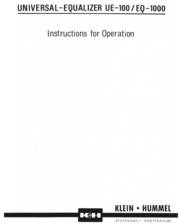Warum es das Handbuchnur in Englisch gab, ist .....
Doch wer mit diesen teuren Geräten zu dieser Zeit hantierte, der mußte recht gut Englisch können. Die anderen Meßgeräte, die Oszilloscopes von HP und Tektronix usw. und auch die Audio-Analyser kamen fast alle aus USA und da gabs nichts in Deutsch.
.
INSTRUCTIONS FOR OPERATION
OF UE-100/EQ-1000 UNIVERSAL EQUALIZER
GENERAL: The UE-100 / EQ-1000 is a piece of precision equipment designed to offer the greatest amount of equalizing flexibility over the entire audio range. It contains solely R-C components and not a single choke (L) so that no sharply tuned C-L resonant circuits are used and therefore the danger of "ringing" and "overshoot" is eliminated.
CONNECTION: The UE-100 / EQ-1000 may be electrically connected into any circuit position where a level of at least -lOdBm is found. This may be in a microphone circuit after a high gain preamp or it may be in a line level application where it is most apt to be used.
The unit is delivered for operation of 220/110 Volt nominal line voltage 50-60 cps and comes with a three conductor line cord providing for a three-prong line plug with ground pin, or a separate ground wire for clamping to the outlet box.
The input and output connections are provided with mating plugs which are to be wired with a shielded pair to the circuit. The ground connection is always the one opposite the plug's keyway (PINS 1 & 2). Be sure to observe polarity by connecting like color input and output leads to like pin numbers.
IMPEDANCE: Like all devices coming from Germany and observing the broadcast standards there, the UE-100 / EQ-1000 needs never to be terminated!
.
In and Out
INPUT: The input impedance is 3.000 Ohms and therefore bridging across any 600 Ohm line. It will operate properly from ANY impedance from 0-3000 Ohms. You must ascertain whether the amplifier or other circuit component directly preceding the UE-100/EQ-1000 needs to be terminated or not.
If, for example, you are feeding the UE-100/EQ-1000 from an Ampex or other tape recorder requiring its line output to be terminated in 600 Ohms, then you must either provide a 600 Ohm resistor across its output or, as many such recorders provide, switch the termination switch on the back of its amplifier to "on".
OUTPUT: The output source impedance is 30 Ohms and will operate into any impedance of 200 Ohms or higher without termination. It is well to check the entire circuit, including the UE-100/EQ-1000 in its "flat" position after installation, to make sure of completely linear response. Should you find a rising response characteristic at the upper frequency end, it might point to the fact that the input transformer of the device in your layout which follows the UE-lOO/EQ-1000, must be impedance
matched exactly and may not look back at the 30 Ohms it sees at the output of the UE-100/EQ-1000.
If this is the case, simply insert in each side of the line from the UE-100/EQ-1000 output (if operated balanced) a resistor which is half the difference between 20 Ohms and the required input impedance of the ensuing device.
For example: Your amplifier next following the UE-100/EQ-1000 requires a 600 Ohms input termination. Using the formula Z - 30/2, would give you 285 Ohms as the value of each of the two series resistors to be inserted in the output of the UE-100/ EQ-1000. For unbalanced operation insert the entire resistance (in the example 570 Ohms) in the high side.
GAIN: The UE-100/EQ-1000 comes set up for no-loss operation. It may be switched for a gain of 5dB by removing the four front rack screws, sliding the unit out of its case, and pushing the slide switch atop the amplifier unit to the M+5M position. Vernier adjustment of the gain of the unit may be made by means of the screwdriver pot "P8-1".
EQUALIZATION SETTING: The UE-100/EQ-1000 permits a vast selection of settings, most of which are self explanatory from the symbols on the front panel. Here is a review of the possibilities:
CUT-OFF FUNCTIONS: The bottom right and bottom left rows cf buttons select the high and low frequencies respectively at which the cut-off reaches the -3 dB point. Select either the white button for flat response or one of the appropriate frequencies. By means of the slide switch directly above the buttons select a slope of either 12 or 24 dB/octave.
DROOP FUNCTIONS: One high and one low frequency droop selector switch is provided for gradual roll-off effects. The low frequency switch is marked "60 cps" and the high frequency switch "10KC". A constant slope of 6dB/octave in 3dB steps is available at each switch.
BOOST FUNCTIONS: The top right and top left rows of buttons select the high and low frequencies respectively at which the boost is to be made. Select either the white buttons for flat response or one of the appropriate frequencies. By means of the slide switch directly below the buttons, select a slope of either 6 of 12dB/octave. Rotary dB selectors below the buttons then select the number of dB boost at the selected frequency. The +18 and +20dB positions of these switches are yellow in color as are the 12dB/octave positions of the slope switches, indicating that this amount of boost is available only in the 12dB/octave boost positions.
BAND PASS FUNCTIONS: The center section is devoted to band-pass and band-reject operation. The section is divided by a diagonal line into two separate and distinct parts. Each part operates independently. First select one of the three buttons near the bottom of the panel. The center button (white) is for flat operation, the one above it for band-pass, the one below it for band-reject.
The two horizontal rows of buttons marked with frequency numbers serve to select the rising or falling slope respectively.
The numbers above the top and below the bottom buttons give the 3dB point of the curve while the numbers between the buttons give the peak frequency or turn-back frequency. You must always push one button in the top end one in the bottom row of the section used. If you select two buttons vertically in line you will get a band-pass or band-reject curve with its peak at the number between the buttons and its 3 dB points at the frequencies shown above and below. If you now push top buttons going left or bottom buttons going toward the right you will broaden the pass. Now select the amount of pass or reject at the peak frequency using the selector switch below up to 14 dB in 2 dB steps.
While it is permissible to select a top button to the right of a bottom one, this will narrow the band at the expense of the height of it. Always remember that only the bottons on one side of the center dividing line are associated with each other.
You may utilize all of the available equalizing functions of the UE-100/ EQ-1000 simultaneously to achieve maximum influence on the response.
"IN-OUT" SWITCH: In the center of the front panel is a power switch and pilot light for same and above that the rotary selector which allows instant switching of the equalizer IN or OUT of the circuit. This switch is so arranged that in its OUT position it leaves it the circuit the input and output stages and transformers of the unit so that both the gain and impedance specifications are maintained.
Mechanics and Maintenance
MECHANICAL MOUNTING: The UE-100/EQ-1000 is NOT standard 19" rack width and therefore must be operated in its housing. If it is desirable to rack mount it, it may be possible for you to cut out the standard 19" rack mounting angles to accept this slightly wider format. In such a case, you may obtain from us the necessary mating connestors to fit the back of the equalizer itself.
MAINTENANCE: The UE-100/EQ-1000 uses tubes which may be obtained locally or you may order from us the original ones used. In case of failure of any of the assemblies making up the unit, this assembly maybe removed as a block and sent to us for replacement or repair.
.


